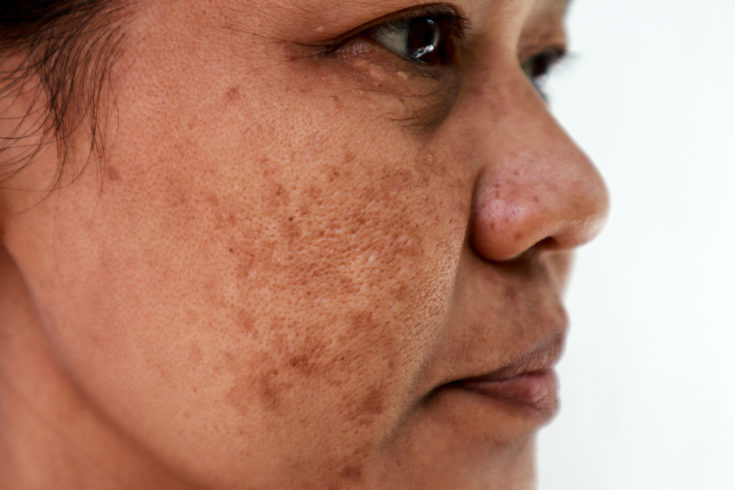Disclosure: This post may contain affiliate links, meaning we get a commission if you decide to make a purchase through our links, at no cost to you. Please read our disclosure for more info.
On the road to pregnancy, women experience a lot of physical changes along with the development of the child inside her body. Aside from changes like a growing belly and breasts becoming full when milk is produced as a woman completes the pregnancy cycle, pregnant women also experience an obvious change in their skin condition.
If you are pregnant, you may notice some dark or brown patches of skin on your forehead, upper lip and cheeks. This skin condition is called “melasma” and around 50-70 percent of women get this during pregnancy. Often called ‘the pregnancy mask’, melasma can result in unsightly appearance and a lot of pregnant women are looking for some ways to deal with this condition.
Melasma, along with sunspots, freckles and post-inflammatory hyperpigmentation (caused by acne, eczema, abrasion, etc.) are among the most common pigmentation concerns for Asians. For your options in pigmentation treatment in Singapore, especially if you are pregnant, you can set an appointment at One Face Skin and Aesthetic Clinic. At One Face, we offer a personalized and friendly approach to patients and provides the most suitable, customized options for each patient.
For the would-be mothers out there, we’ve prepared this simple guide on what pregnancy melasma is and some tips on how to deal with this skin condition.
In This Post:
What is Melasma?
Melasma is a skin condition where dark (brown, tan or gray) spots appear on the skin. It appears mostly on the face like on the forehead, cheeks, nose and upper lip – areas mostly sun-exposed. It can also sometimes appear on the chest and arms.
Facts about Melasma:
- The dark patches of melasma appear symmetrical – meaning on both sides of the face.
- Mostly affects women but can occur in men too, but rarely.
- Usually occurs in women with darker skin types and most common with women of Asian, Mediterranean or Latin backgrounds
- The cause of melasma is still unknown but factors such as age, genetics, hormonal changes from pregnancy or contraceptive pills, and chronic sun or Ultra Violet (UV) light exposure are considered as the precursors of this skin condition
Melasma During Pregnancy
Although the cause for melasma is not yet known, most experts associate the occurrence of melasma in pregnant women to hormonal changes which are a normal response of a woman’s body when pregnant. During pregnancy, there occurs an elevated level of estrogen and progesterone hormones that stimulate the production of melanocytes (cells responsible for skin pigment production) and these melanocytes are stimulated by natural light (from sun exposure) thus producing excess pigment.
Melasma usually can start in the first trimester of pregnancy and the increased skin pigmentation can continue until delivery. For most women, the dark spots caused by melasma eventually fades after childbirth, however, there are some instances that it does not. In this case, seeking medical help can be a solution and nowadays there are a lot of available treatments.
Tips on How to Deal With Melasma When You Are Pregnant
Being pregnant, women should always be careful when taking medications or getting some treatments. For melasma treatment, there are a lot of options but most of these treatments are not recommended if pregnant. Most would advise getting a full treatment after childbirth or after breast-feeding.
For pregnant women, the recommended approach is to lessen the effect of melasma – that is to prevent further darkening. For the management of melasma while you are pregnant, here are few tips gathered from experts:
- Apply sunscreen – Sunscreen is a very helpful tool in treating and preventing further darkening of dark spots caused by melasma. Before application, check first the sunscreen product label or consult your doctor to be sure the product is safe for your baby.
- Avoid exposure to the sun – Having melasma, staying under the sun, especially in midday, can worsen the condition. It is recommended that sunglasses, wide-brimmed hats or other forms of sun protection be used when to protect the skin.
- Avoid saunas and steam rooms – Excessive heat is also said to trigger pigmentation thus going to saunas or steam rooms should be avoided.
- Choose plant-based products for the treatment – Treatments that contain ingredients such as kojic acid, arbutin, and azelaic acid can be used during pregnancy. These products can help minimize melasma by blocking pigment production. A reminder though, check with your doctor first before choosing a product.
- Don’t use skin-bleaching and lightening creams – Skin-bleaching and lightening creams particularly those containing hydroquinone, retinoids, and steroids is not recommended if pregnant.
Additionally, since treatment for melasma to pregnant women is limited due to possible risks to the baby, others would also recommend make-up to conceal the skin discoloration, even just temporarily.
Take Note
The condition of your melasma can also be linked to your skin type/sensitivity and heredity, thus what works for others may not be giving out good results on you. Also, in treating melasma, to be sure that you and your baby are safe, it is best to consult first to consult with your doctor. Moreover, doctors can design an approach suiting your condition and a more personalized approach rather than a general one, can make a difference.
At One Face, we offer a lot of options from the use of topical skincare products to other treatment options such as pigmentation lasers. Of course, the recommended approach will be based on the severity of your condition and your preferences, and that is after a thorough consultation. To see what works best for you, set an appointment with us today.
One Face Skin & Aesthetics Clinic
1 Tras Link, #02-01 Orchid Hotel,
Singapore 078867
+65 6222 2262

